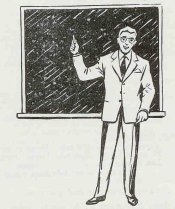 The mention of Thomas Prendergast in my last post sparked a couple of enquiries. Who was he and what was his method?
The mention of Thomas Prendergast in my last post sparked a couple of enquiries. Who was he and what was his method?
For all his working life, Thomas Prendergast (1806 – 1886) was, like his father before him, a civil servant in the East India Company, during which time he learned at least two of India’s indigenous languages, Hindustani and Telugu. On retirement in his fifties, he returned to England where (now blind) he spent his remaining years developing what he called his ‘Mastery’ system, published in 1864 as The Mastery of Languages or, the Art of Speaking Foreign Tongues Idiomatically, along with accompanying teaching materials in a variety of languages.
Essentially, his method involved the cumulative memorization of a set of exemplary sentences and the subset of sentences that can be derived (or ‘evolved’) from each of them. With remarkable foresight, Prendergast had observed that children seem to achieve fluency by memorizing entire sequences of words – what we would now call chunks or constructions. They are also able to combine and re-combine these elements in creative ways. Accordingly, Prendergast set about trying to identify the most frequent constructions, albeit only those that qualified as well-formed sentences. Prendergast’s sentences were not graded from the simple to the more complex. Rather, they were deliberately contrived to pack in as much syntax as possible, the test of their usefulness being the number of less complex sentences that could be generated from them. Because children are able to derive the grammar from constructions without explicit instruction, Prendergast was adamant that all grammar explanation was ‘prohibited’.
Prendergast’s Mastery system seems to have enjoyed some degree of success in its time and was adapted to the teaching of a number of languages. It was soon overtaken, however, by the arrival of the Reform Movement, and the kind of ‘direct method’ that was popularized by M. Berlitz.
Nevertheless, in many ways, Prendergast’s system prefigured developments in methodology that were way ahead of their time. One of these was the use of what later came to be known as substitution tables: i.e. tables that display the way that words and sentence elements can be combined. Also, his belief that mastery of a limited ‘core’ of structures and vocabulary could serve as a foundation for later proficiency contrasted with his contemporaries, for whom principles of selection or grading were largely ignored. But perhaps most remarkable was his insight that fluency, at least in part, results from having a memorized store of fixed and semi-fixed formulaic utterances. Unfortunately, by supposing that these ‘chunks’ consisted of whole, syntactically well-formed sentences, his method – in Howatt’s words – ‘turned the wrong corner’ (2004, p. 176). It would take another half-century before this misstep would be corrected, and the units of fluent production would be re-envisaged, neither as words nor sentences, but as ‘word groups’ (Palmer 1921).
Nevertheless, to give you a flavour of just how innovative Prendergast was, here is a selection of quotes:
On grammar
‘Although no one has ventured to maintain that the words “language” and “grammar” are synonymous, there prevails the notion that a knowledge of grammar is equivalent to a knowledge of the language to which it relates’ (1868, pp. 78-79).
‘Grammar is sometimes defined to be the law by which language is regulated; but in reality, grammar is deduced from language, and is not the regulator, but the regulatee’ (1864, p. 191).
‘No definition of the term “grammar” enables us to understand why that science should be studied first’ (1868 p.65).
‘The definition which styles it “the art of speaking correctly” has so little truth in it, that many persons who are well-versed in grammar are either incapable of speaking at all, or else, when compelled, are so embarrassed by the conflicting recollections of rules, exceptions, cases, tenses, moods, and genders, that they cannot help speaking incorrectly. The grammar itself is the cause of their speaking ungrammatically’ (1868, p.79).
‘Usage is the only law. Usage constitutes the whole code’ (1864, p. 203).
 On acquisition
On acquisition
‘Studying a language is not acquiring it’ (1864, p. 200).
‘Some say that we must think in a foreign language before we can speak it well … But it is not by thinking in a language, but by not thinking in it, that children speak it idiomatically and fluently’ (1868, pp. 233-4).
‘Illiterate people and children acquire the power of speaking the most difficult languages with fluency, by learning a very few practical sentences, and by ringing the changes on them’ (1864, p. 209).
‘Children and imbeciles succeed, in spite of their ignorance of grammar and books’ (1864, p. 209).
On vocabulary learning and chunks:
‘[Oral] composition is not the compounding of sentences according to the prescriptions of the grammarian; but it is the putting together of idiomatic phrases by intelligent efforts of memory’ (1868, p.32).
‘[Children] import an idiomatic combination of words, together with the ideas belonging to it; they immediately begin to employ it for practical purposes without alteration; and they repeat it so often that it becomes stereotyped in the memory’ (1864, p.34).
‘Language is a tree which is propagated not by seeds, but by cuttings; not by words but by sentences’ (1864, p. 19).
On idiomaticity
‘Many adults live abroad for years without ever attaining this power of expressing themselves idiomatically; and many teachers are staggered by their most advanced pupils’ total incapacity in this respect. The failure arises solely from their not having committed idiomatic sentences to memory at first.’ (1868, p.44)
On memorization:
‘To reproduce sentences verbatim, is to speak idiomatically; and therefore the genuine colloquial knowledge of a language is attained by repeated efforts of the memory, not by vigorous exertions of the reasoning faculties’. (1864, p.48)
‘When a man has committed to memory a few well selected sentences, each containing different constructions, and has acquired the power of putting them together in all their variations, one rapid perusal of the grammar will suffice to convince him that he is already in possession of the whole syntax of the language’ (1864, pp. 209-210).
‘In learning anything by heart, repetitions are indispensable, and the more they are distributed throughout the day, the smaller will be the number required to impress the foreign phrases on the memory’ (1870, pp 6-7).
On task repetition:
‘It is useful [for the learner] to frequent public places as a listener; to ask several people in succession for the news of the day after having carefully read it all beforehand; […] but especially to engage strangers in conversation in subjects which he has previously discussed with others, in order that he may repeat his own questions and observations, with additions and improvements. These second-hand conversations are by far the most instructive. (1864, p. 93)
On partial competence:
‘A language learned in miniature … may seem, at first sight, to be miserably defective; but a vast reduction of labour is effected by this plan, and it creates a great facility for the beginner in supplementing all his deficiencies’ (1864, p. 131).
References
Howatt, A.P.R. (with H.G. Widdowson) (2004) A history of English language teaching (2nd edition). Oxford: Oxford University Press.
Palmer, H.E. (1921) The Principles of Language-study. London: Harrap.
Prendergast, T. (1864) The Mastery of Languages, or the Art of speaking Foreign Tongues idiomatically. London: R. Bentley.
Prendergast, T. (1868) Handbook to the Mastery Series, New York: Appleton and Co.
Prendergast, T. (1870) The Mastery Series: French (new edition). New York: Appleton & Co.

















Recent comments